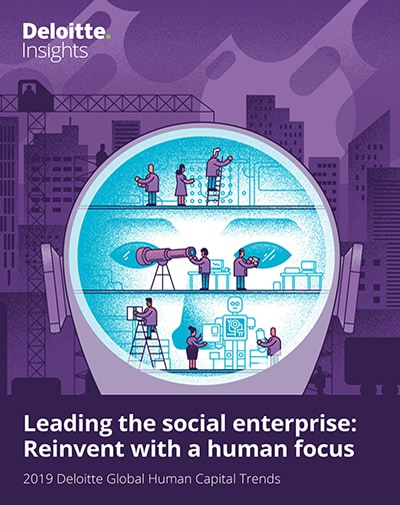
Talent mobility: Winning the war on the home front 2019 Global Human Capital Trends
8 minute read
11 April 2019
An organization’s biggest potential talent source may be its own people. But why do so many organizations find internal talent so hard to access?
Organizations have historically focused on external recruiting to find people for new roles, but with growing skill shortages and low unemployment rates, they are now finding that acquisition alone isn’t enough to access the capabilities they need. To fuel growth, organizations need to more effectively tap their current workforce to identify and deploy people with the required skills, capabilities, motivation, and knowledge of the organization, its infrastructure, and its culture. Creating better programs to facilitate internal mobility can pay off in multiple areas: growth, employee engagement, and business performance.
As talent markets get tighter and the world becomes more connected, a major new trend has emerged from our research: the need to improve internal talent mobility to more effectively move people among jobs, projects, and geographies. This year, internal talent mobility has become a C-suite-level topic, with 76 percent of our survey respondents rating it important and 20 percent rating it one of their organization’s three most urgent issues.
It’s not hard to understand why. For many organizations, their biggest potential source of talent is to access the enterprise’s own workforce and internal talent market. Surprisingly, however, that market is often undervalued and even overlooked, and many organizations find it amazingly difficult to access. The sad and maddening reality is that employees generally find it easier to find new—and more attractive—opportunities in another organization than to explore and move to new roles at their current employers.1 In this year’s Global Human Capital Trends survey, more than 50 percent of respondents told us that it was easier for employees to find a job outside their organization than inside (figure 1), a situation that leaders would do well to address.

Why is internal mobility important?
Learn more
Watch the related company story videos for this trend: Allergan and Shawmut
View 2019 Global Human Capital Trends
Download the Deloitte Insights and Dow Jones app
Download the full report or create a custom PDF
Deloitte’s 10th annual Global Human Capital Trends Report is coming soon. Get it first by signing up!
Organizations have many reasons for starting to explore internal mobility in earnest. Hiring people with critical skills is highly competitive; workers who want to reinvent themselves don’t necessarily want to leave their current employer; internal mobility can be a way to embed collaboration and agility into an organization’s culture, which is one of the key attributes of becoming a true social enterprise; and agile organizations and career models dramatically improve employee engagement and commitment. Ingersoll Rand, for example, developed a robust internal career program to help employees reskill themselves for new positions within the organization, and invested in an interactive, analytics-based technology solution that allows them to explore and access alternative roles and career paths across the company. The result: a nearly 30 percent increase in employee engagement.2
Another major driver for internal mobility is the need for many organizations to globalize their operations as they expand into the fast-growing economies of Asia, the Middle East, and Africa. Schneider Electric, one of the largest French manufacturers of electrical systems and components, changed its structure from being a Paris-based, centralized operation to having four global headquarters: one in France, one in the United States, one in China, and one in India. The company now develops and markets products in each of these geographies, requiring the organization to create a culture of mobility, diversity, and inclusion. By creating four headquarters, the company can now offer roles in all four places that were available in only one location before, which increases both the need and the opportunity for employees to develop and grow into new roles. Schneider is now investing in new technology solutions to create more mobility options for its expanded organizational talent markets around the world.3
The shift toward flatter organization models also creates a greater need for internal mobility. As organizations start to operate in teams and networks, managers are realizing that open access to the diverse skill sets, backgrounds, and experiences held by the organizations’ own people is essential for success. To staff projects and programs as they grow, team leaders have to find expertise throughout the network, which is difficult if the organization lacks an active and open internal mobility process.
Why is internal mobility hard?
Although internal mobility is a high priority, it’s not easy to do well. Only 6 percent of respondents told us they believe they are excellent at moving people from role to role; 59 percent rate themselves fair or inadequate (figure 2).

One reason internal mobility is difficult is that most organizations are modeled around hierarchical structures: systems that people enter at the bottom and spend years working their way up to increase their influence, impact, and rewards. But while organizations have spent decades building career and promotion models to help people move up the pyramid, that’s not the same thing as having a vibrant, easy-to-navigate internal mobility market and culture across the entire organization. Only 32 percent of this year’s survey respondents believed that their organization’s employees have opportunities to move between operating divisions. Forty-nine percent of respondents, the largest proportion, identified the lack of processes to identify and move employees as a top-three barrier to internal talent mobility (figure 3). Siloed organizational models make it hard for managers to look for talent outside their own fiefdom, and block employees’ views into opportunities elsewhere in the enterprise.

What’s more, incentives are rarely set up to encourage hiring from within. Unless hiring managers are actively encouraged and rewarded for hiring internal candidates, they may pass over existing employees looking for development. Equally problematic, an internal candidate’s current manager may resist other departments’ or managers’ efforts to recruit the person unless incentives are in place to encourage managers to develop subordinates’ skills and support their growth. Indeed, 46 percent of this year’s survey respondents told us that managers resist internal mobility. Team leaders who are rewarded for producing results but not for promoting internal mobility have no reason to welcome the prospect of losing a high-performing team member—creating an obstacle to mobility, no matter how hard HR promotes mobility programs.
Culture is also a barrier in many organizations. Seventy percent of respondents told us that talent mobility expectations, the culture around talent-sharing, and decision-making around mobility were inadequate or only fair at their organization. Technology and systems around internal mobility, too, are often lacking. Forty-nine percent of respondents told us that they have few, if any, tools to identify and move people into new internal roles. Forty-five percent said their employees lacked visibility into internal positions. And in our conversations with clients, many HR leaders tell us that employees find it easier to quit and be rehired than to change positions within the organization because of the lack of systems to enable and promote internal moves.
A source of competitive advantage
Are the problems worth overcoming? Our respondents think so. Beyond looking at internal mobility to fill open positions, our respondents cited several other strategic business reasons for urgently focusing on this issue. Thirty-eight percent are looking at internal mobility to build better leaders, 31 percent cite the need to expand the business, and 32 percent believe mobility is required to increase employee engagement.
At one global engine manufacturing leader, encouraging internal talent movement stems from a firm belief that learning through experience is extremely powerful. One employee we spoke with said that this emphasis makes the company a “playground for learning” and praised “the number of cross-functional moves that take place and how open leaders are to considering high performers for any number of assignments regardless of their technical background.” Not surprisingly, enabling these experiences not only provides learning opportunities, but also raises employee engagement.4
Other organizations that have made substantial investments in internal mobility are also seeing these investments pay off. To take a well-known example, AT&T has spent hundreds of millions of dollars since 2013 on upskilling its employees, both by providing direct education and professional development programs and through tuition assistance. The program’s goal is to fill existing openings with people already at the company, and by that measure, it is succeeding: From January to May 2016, upskilled employees filled half of all tech management jobs and received almost half of the available promotions.5
A global bank offers another illustration of the types of talent market and mobility initiatives organizations are exploring and launching. The bank is building a new function for internal mobility that integrates talent acquisition with career mobility and takes an enterprisewide view and scope. Not only are internal mobility initiatives moving beyond new programs and processes, but leaders’ mindsets are changing to view the company’s entire workforce as a talent market that allows for multidirectional careers. This, in turn, is influencing how leaders think about operating models and organizational structures as internal boundaries become less important and enterprise teams and internal capability markets increase in importance and impact.
Companies like these have caught on to what is becoming more and more self-evident: Internal mobility is a driver of growth in today’s digitally powered, highly competitive global economy. The numbers tell the story: When we looked at the fastest-growing organizations (those growing at 10 percent or more compared to the prior year) in our survey, they were twice as likely to have excellent talent mobility programs than organizations that were not growing at all, and more than three times more likely than organizations whose revenues were shrinking.
Recoding the norms
As organizations reexamine how they approach internal mobility, they need to address a fundamental issue: Internal mobility today is governed by a set of (often unwritten) norms that are outdated and need to be fundamentally recoded for the future needs of today’s workers and organizations (figure 4). It is only through this reinvention that organizations may be able to unlock the potential hidden within its existing workforce.

Not surprisingly, the earliest adopters of this shift have come from the technology industry. Spotify and Facebook are leading examples. At Spotify, internal mobility has become such a core cultural element that employees take on a new role, on average, every two years.6 And at Facebook, employees and managers have conversations about career progression with internal mobility understood as an accepted element.7
Internal mobility, in short, can be a major source of critical talent and competitive advantage. To do it well requires investment and a focus on culture, infrastructure, and incentives—but it’s an investment well worth considering for leaders looking for ways to bridge the talent gap. In an economy where outside talent is becoming more and more difficult to find and attract, looking within can make the crucial difference between struggling and succeeding.

© 2021. See Terms of Use for more information.
Explore the collection
-
From employee experience to human experience Article6 years ago
-
Accessing talent Article6 years ago
-
Rewards Article6 years ago
-
HR cloud Article6 years ago
-
Looking ahead Article6 years ago
-
2019 Global Human Capital Trends Collection





















